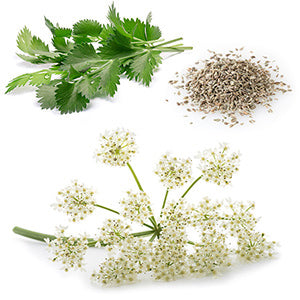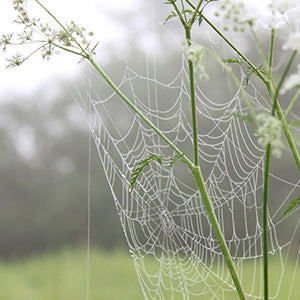How to Grow Anise Herb From Seed
- Latin Name: Pimpinella anisum
- Hardiness Zone: Primarily grown as an annual, Perennial in zones 4 -11
- Days to Maturity: 75+ (leaves), 120+ (seeds)
- Days to Germination: 14-21
- Planting Depth: ½"
- Plant Spacing: 8-12”
- Plant Height: 24-36”
- Growth Habit: Weedy upright with spreading umbel blooms
- Soil Preference: Average, medium dry, well-drained
- Temp Preference: Warm, 65-70° F
- Light Preference: Full sun
- Pests/Diseases: Slugs, wormwood pug larvae
- Flavor: Strong licorice-like flavor
- Benefits: Learn more about anise benefits
- Misconceptions: Anise Hyssop
- Availability: Buy Anise Herb Seed

>>> See Full Herb Grow Guide List <<<
Planting Anise Seed
Soils need to be above 70°F to germinate in about 14 days. Clear garden bed of weeds, roots, and other pieces of debris before direct sowing. Soil needs to have adequate drainage but not too sandy or gravely. Keep the area moist for best aniseed germination. The anise herb requires regular watering, but be sure to check soil with your fingers for moisture. Water consciously--if the soil is adequately moist, hold off on watering until soil has dried a bit. When the anise seedlings poke through the soil, thin as necessary to prevent overcrowding. Opt for outdoor container gardening as anise does well in large terra cotta pots and/or any other decent-sized container.
Growing Anise Herb
When growing anise from seed, be aware of when the first frost will occur in your area that year. Plant after that date. Pay attention to the changing of the season and gauge when soil temperatures will reach 65-70°F for a precise planting date. If a frost does happen after you've planted, there still is a good chance that it will grow. The anise herb seedling is susceptible to cold, but the plant has been known to survive sudden bouts of cold. Keep soil moist until anise has taken root and begins build its stem. At that point, allow soil to dry out just a bit before watering again. Anise does not like over watering and can withstand instances of heat and dryness. Some anise stems can start off pretty weak as well, so, consider staking leggy seedlings as you see fit.
The growing anise herb is known for having little problems with pests. Some suggest that the flavor of the anise oil (anethole) in the herb plant is an insect repellant of sorts. With that said, there is one pest that can be a problem but it is rare. The larva of a type of small brown moth called the Wormwood Pug will feed on the underside of the leaves of the herb. A medium to strong jet of water can remove these pests.
Anise Container Gardening
Similar to garden mustard, parsley, and dill, culinary anise produces a taproot which allows for the herb to quickly establish itself with a weed-like hardiness. Generally, most crops with taproots (i.e. carrot, Daikon, parsnip) do not perform well in pots or container but are best sown in loose, well-tiled garden beds so as not to obstruct root development. However, the anise taproot is not as robust and deep as mustard or carrot, and can thrive just as vigorously in a container up on the patio or porch in full sun. Be sure the container is at least 12” deep to accommodate for the anise taproot. If growing in a container, allow soil to dry between waterings to minimize mold and rot. Container gardening is useful for anise because the plant can be moved about in the garden to serve as a fragrant and all-natural insect repellent.
Harvesting Anise Leaves
Unlike fennel, anise is not commonly grown for its greens, although younger shoots may be somewhat tender while still boasting the same familiar sweet licorice taste. After the seed harvest, anise greens are an ideal crop to be mowed down and used for livestock foraging and grazing. If interested in anise greens for culinary use, snip no more than 60% of the herb's total leaves to allow further growth. Typically, if anise greens are consumed at all it is only in trace amounts, such as dried and brewed in a tea. Simply snip the flowering heads (umbel) at the base of the bloom with a knife or shears.

Harvesting and Saving Anise Seed
Herb seeds are always harvested at the end of the growing season after the blooms have withered and all that remains on the umbel (flowering heads) are heavily seeded pods. Anise seed is similarly harvested like other umbellifer herbs (Apiaceae) such as dill, fennel, chervil, and parsley and generally have two similar but different approaches to collecting seed and ridding it of its flaky husk (chaff).
1. Like every other herb, anise seeds are easiest to harvest at the end of the season after the plant has gone to seed out in the garden. Simply snip off the dry seeded umbel heads leaving a few inches of stem to remain on the heads to make shaking out seeds easier. For smaller harvests, heads may be placed in a paper sack and shaken vigorously to release seeds. For larger harvests, shake and manually extract seeds over a bin, allowing both seeds and fibrous husk (chaff) to collect.
2. Anise Seeds may also be collected earlier in the season while flowers are still in bloom and seeds are underdeveloped. White flowering umbel heads may be snipped from the plant just as if it were early fall, but left to cure and dry upside down in a cool, dry, and properly ventilated space.
3. Whether aniseed is harvested at the end of the season or clipped earlier in the summer and left to dry, the seeds will need to be separated from the dry pile of fibrous chaff which they are now mixed. The easiest way to separate seed from husk is to simply pour all the harvested seed into a larger bin, preferably outside, to allow airflow to whisk away the chaff. Anise seed is heavy enough to fall directly into the bin, while the fibrous husk is light enough to be carried away with the breeze.
Once anise seed is harvested and separated from the chaff, seeds can be safely stored in a cool dry place for sowing next year or, for culinary use, place in a food dehydrator or in the oven for an hour at about 175°F and stored in an airtight jar once cooled.
Anise Pests and Insects
As a member of the always fragrant Apiaceae family, anise herb is often cultivated in the garden as part of natural and beneficial insectaries. Much like other herbaceous annuals in the Apiaceae family such as angelica, dill, and fennel, pests are generally repelled by the herb’s piquant and aromatic oils. And similar to calendula and mint, garden anise emits highly pungent chemicals known as terpenes found in many plants which serve as an all-natural pest control, often sold as organically concentrated insecticide. Due to its broad and accessible “umbrella-like” blooms, many species of Apiaceae like anise have been found to be ideal gathering spots for beneficial insects and pollinators that feed on smaller, more harmful pests such as aphids, mites, and thrips. Anise is a well-known crop for hosting beneficial ladybugs, tachinid flies, and the always aphid-hungry parasitic wasp.
Anise Companion Planting
Anise is one of the most desired companion plants in the garden because of its natural ability to both repel harmful insects while attracting beneficial ones. Culinary herbs belonging to the Apiaceae family are widely grown as companion plants directly alongside summer crops for their pungent oils, fragrance, and terpenes which are known to create an inhospitable environment for smaller, more harmful insects. The licorice-scented aromatics from the anise plant and other similar Apiaceae crops are also believed to help mask the presence of more vulnerable Brassicas, leafy greens, and vegetable crops from predatory insects. Although the anise plant thrives in pots and containers, grow anise directly in the garden for optimal pest control. If allowed to grow in the garden bed, the natural and organic insecticide terpenes of the anise plant will enrich the surrounding soil to help bolster overall pest management. Members of the Apiaceae family such as dill, rue, and carrot should never be sown near each other, as their genetic similarities may cause cross-pollination, spoiling the flavor and productivity of these related species.

Anise Troubleshooting
Although culinary garden anise is not susceptible to too many pests and insects, plants may be simply sprayed with a light stream of water to remove any possible infestation. Plants are susceptible to fungal diseases from oversaturation in poorly drained and ventilated gardens. As mentioned, allow soil to dry between waterings to help alleviate oversaturation. Always water soil directly at the root base to avoid wetting foliage, causing possible fungal development that could lead to alternaria blight, powdery mildew, algae-based downy mildew, and rust. Both fungal-based and algae-based diseases require water to thrive, so reduce watering and allow soil and foliage to thoroughly dry for recovery. Anise may also benefit from a systemic fungicide should proper drying and ventilation not treat the fungal disease. Remove any plants from the garden whose leaves are quickly browning and spotting from the aggressive fungal blight.
Anise Seed and Herb Benefits
Like many culinary herbs, anise has been cultivated for thousands of years for its countless purported medicinal and therapeutic benefits. While aniseed is dense in essential vitamins and nutrients, its robust and fragrant flavor keeps it from being consumed in large quantities like flax, chia, or quinoa. Aniseed has widely been used as a homeopathic remedy for alleviating such maladies as asthma, insomniac, epilepsy, indigestion, and various types of inflammation. Since then, concentrated anise oil, or essential oil, has become the standard by which medicinal and homeopathic anise is used today. Anise oil is popularly sold as a topical anti-inflammatory able to boast both fungicidal and antimicrobial properties. Benefits may be enjoyed through essential oils, eating the seed raw, or harvesting leaves for a cinnamon anise green tea.
Anise vs Star Anise vs Fennel
Despite sharing similar names and flavor, the shrubby annual herb Anise (Pimpinella anisum) and the perennial magnolia-like tree Star Anise (Illicium verum) are completely different species, yet are constantly confused for each other despite the seeds looking very different. Anise seeds share a very similar soft and flakey appearance to other weedy members of the Apiaceae family such as dill and caraway, while Star Anise seeds are firmer and form in woody star-shaped pods, always eight seeds per pod. When cooking, anise and star anise may be used interchangeably, despite star anise having the more pungent, bitter, and prominent flavor of the two seeds. Anise is often used raw while star anise must be ground due to its larger size.

Like anise and star anise, culinary fennel (Foeniculum vulgare) is another licorice-tasting seed that is also confused with these two crops, despite being a completely unrelated species. Fennel may be substituted in the kitchen for anise and star anise but, like aniseed, fennel seeds are prepared and eaten raw whereas the larger star anise must be ground. One of the fundamental differences between the three species is the edibility of their plant greens. Fennel is a versatile herb crop able to be consumed entirely from the bulb, stem, greens, to the seeds whereas the anise plant is almost always grown exclusively for seed, with no other portion of the plant being harvested. Star anise matures into a 25-foot tall evergreen tree similar to magnolia that, like anise plant, is grown solely for seed harvest.











